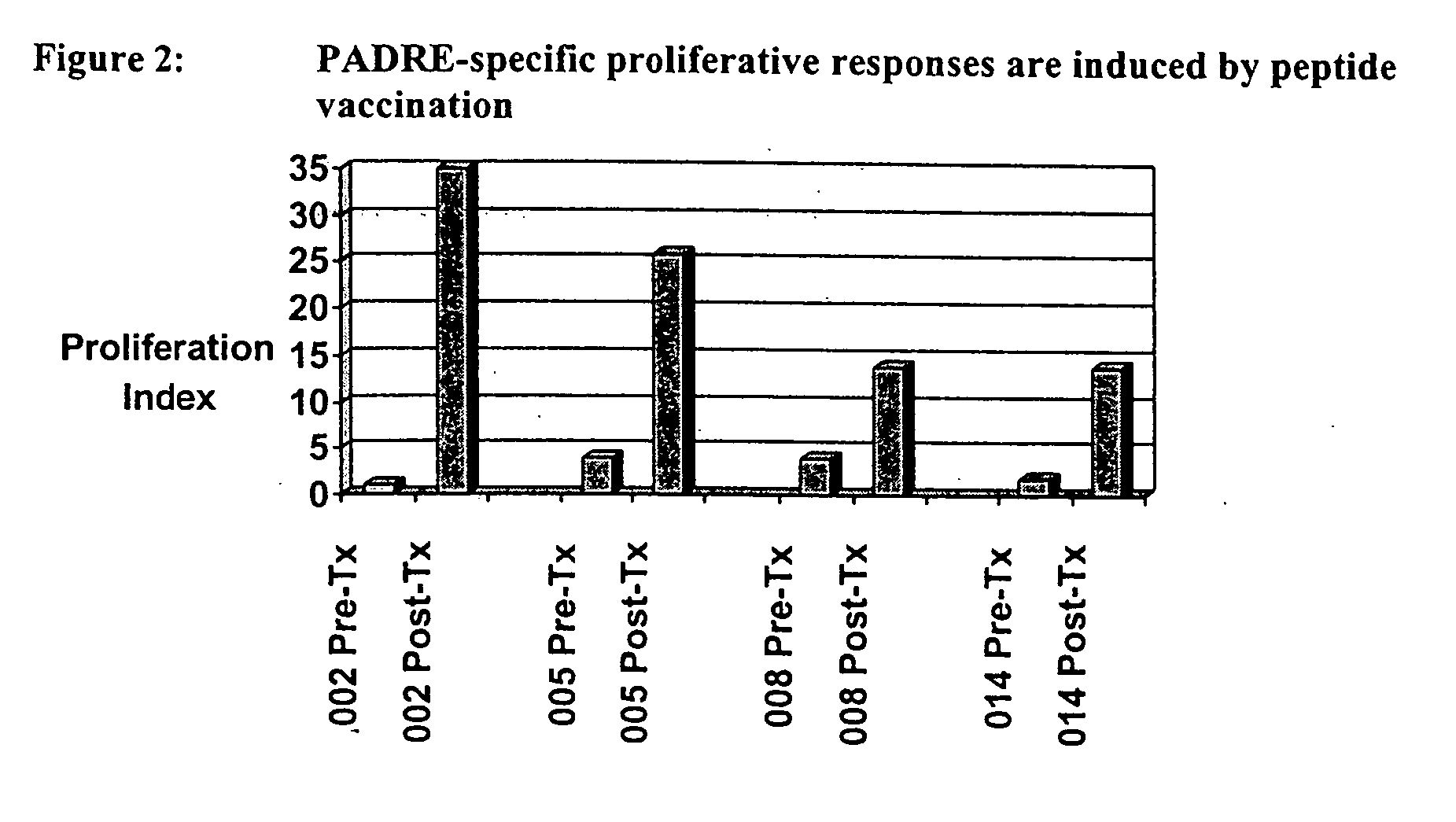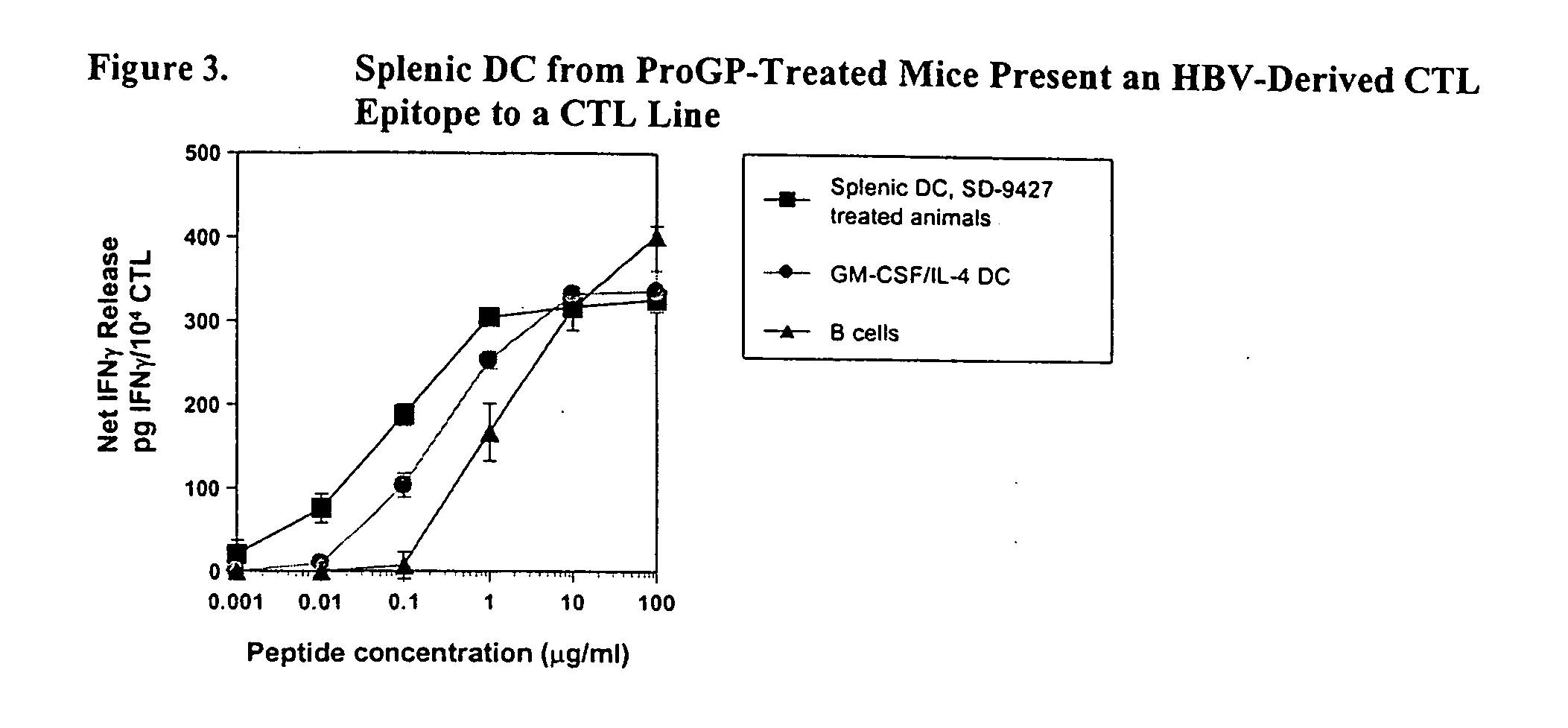HLA class I A2 tumor associated antigen peptides and vaccine compositions
a tumor and antigen peptide technology, applied in the field of biochemistry, can solve the problem of less than 50% of patients being cured
- Summary
- Abstract
- Description
- Claims
- Application Information
AI Technical Summary
Problems solved by technology
Method used
Image
Examples
example 1
[0264] Selection of Tumor Associated Antigens
[0265] Vaccines which bind to HLA supertypes, A2, A3, and B7, will afford broad, non-ethnically biased population coverage (83-88%). Since the A2 supertype is broadly expressed in the population (39-49%), peptides which bind to this family of molecules provide a reasonable starting point for the use of peptide-based vaccines. While the A2 vaccine targets patients that express HLA-A2 molecules, the approach can be readily extended to include peptide(s) that bind to additional alleles or supertype groups thereof.
[0266] Whole proteins often induce an immune response limited to specific epitopes that may be ineffective in mediating effective anti-tumor immune responses (Disis et al., J. Immunology 156:3151-3158 (1996); Manca et al., J. Immunology 146:1964-1971 (1991)). A epitope-based vaccine circumvents this limitation through the identification of peptide epitopes embedded in TAAs. Exemplary TAAs are set forth in Table 12.
[0267] Peptides...
example 2
[0277] Identification of Motif-Bearing Peptides
[0278] Protein sequences from the four targeted tumor antigens (CEA, p53, MAGE 2 / 3 and HER2 / neu) were analyzed, to identify 8-, 9-, 10-, and 11-mer sequences containing the HLA-A2 supertype binding motif. This motif [leucine (L), isoleucine (I), valine (V), methionine (M), alanine (A), threonine (T), or glutamine (Q) at position 2, and leucine (L), isoleucine (I), valine (V), methionine (M), alanine (A), or threonine (T) at the C-terminus; see Table 2] is the predominant factor in determining peptide binding to the HLA molecules within the A2 supertype (see, e.g., del Guercio et al., J. Immunol., 154:685-693 (1995); Sette, A. and Sidney, J., Cur. Opin. Immunol., 10: 478-482 (1998); Sidney et al., Immunology Today, 17:261-266 (1996)). Nonamer and decamer sequences were further characterized using an A2-specific algorithm to evaluate secondary anchor residues (Ruppert et al., Cell 74:929-937 (1993); Gulukota et al., J. Mol. Biol. 267:125...
example 3
[0279] Molecular Binding Assays
[0280] Native sequences containing HLA-A2 peptide motifs were tested directly for binding to human class I HLA molecules, since a subset of motif-bearing peptides bind with a biologically significant affinity, data depicted in Table 6. An affinity threshold ≦500 nM to the HLA-A2 molecule was previously shown to define the capacity of a peptide epitope to elicit a CTL response (Sette et al., J. Immunol. 153:5586-5592 (1994)). A competitive inhibition assay using purified HLA molecules was used to quantify peptide binding. Motif-bearing peptides were initially tested for binding to HLA-A*0201, the prototype member of the HLA-A2 supertype. Peptides binding to A*0201 with an IC50≦500 nM were subsequently tested for their capacity to bind other predominant molecules of the A2 supertype: A*0202, A*0203, A*0206 and A*6802 (del Guercio et al., J. Immunol., 154:685-693 (1995); Sette, A. and Sidney, J., Cur. Opin. Immunol., 10: 478-482 (1998); Sidney et al., Im...
PUM
| Property | Measurement | Unit |
|---|---|---|
| concentration | aaaaa | aaaaa |
| concentration | aaaaa | aaaaa |
| concentrations | aaaaa | aaaaa |
Abstract
Description
Claims
Application Information
 Login to View More
Login to View More - R&D
- Intellectual Property
- Life Sciences
- Materials
- Tech Scout
- Unparalleled Data Quality
- Higher Quality Content
- 60% Fewer Hallucinations
Browse by: Latest US Patents, China's latest patents, Technical Efficacy Thesaurus, Application Domain, Technology Topic, Popular Technical Reports.
© 2025 PatSnap. All rights reserved.Legal|Privacy policy|Modern Slavery Act Transparency Statement|Sitemap|About US| Contact US: help@patsnap.com



